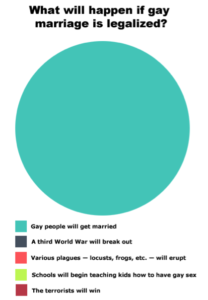The topic of romantic love and marriage has been a focus in society and politics for decades. Whether it manifests in terms of interracial marriage or the question of same-sex marriage, people have very strong opinions on who should be allowed to married. Today, the biggest issue is same-sex marriage. Opposition comes strongest from various religions, and many feel that allowing gays to marry will “ruin the sanctity of marriage.” The concerns that society has about marriage now are no different than they were decades ago.


Interracial marriage was a legal issue in the United States up until the end of the 1960s. Through the end of the 1800s and the first half the 1900s, many states slowly started repealing laws that made interracial marriage illegal. Before 1967, all but 14 states in the U.S. had either repealed or never passed laws that outlawed mixed marriage. However, in 1967, the Supreme Court ruled anti-miscegenation laws unconstitutional, making mixed marriage legal in all 50 states. However, at that point, only less than half of one percent of all marriages in the United States were mixed. Despite the legalization of interracial marriage, the stigma that existed kept the number of those marriages down. Today, same sex marriage is in a similar place. Many states still ban same-sex marriage, and supporters of the ban worry about how allowing gays to marry will affect the state of families and marriage in America. This worries existed during the debates of interracial marriages as well. However, every year, more and more states legalization same sex marriage. However, the stigma that, to an extent, still follows interracial marriage now follows same-sex marriage as well. This attempt to control the institution of marriage mirrors the way that media changes the viewpoint of romantic love in general, and how we, as a society should analyze romantic love, and what our expectations in that area should be.
Romantic love is often referred to as a destructive concept in The Bluest Eye, and readers can see how it affects Pauline’s life. Because she is very influenced by the stories she sees in movies, she creates inner narratives about how her life will go that become self-fulfilling prophecies. Based on the love she sees in the media, Pauline thinks that love has a lot to do with possession and physical beauty, and that idea is reflected in how she allows her husband to treat her. She hoped that one day a stranger would meet her and accept what she sees as her ugliest part—her bad foot. When she meets Cholly, the fulfillment of that fantasy blinds her to the fact that he may not be the best man for her, and eventually leads to unhappiness. Pauline had spent a lot of time watching movies and began to compare herself to others on the idea of an “absolute beauty scale.” Pauline believed that if her beauty could compare to that of the white women around her, Cholly would come back and take care of her like the media portrayed romantic man should.
The way that Pauline envisions finding love is not uncommon from the way many young girls think they will find a husband. Many of the images we subject girls to from very young age depict love as destiny—something that you wait to happen to you. Most Disney movies show the lead woman as helpless, fragile, and beautiful, waiting for a strong, powerful man to rescue her from whatever problems she is involved in. Romantic love is also shown as something that happens instantly, with one kiss or one chance meeting. The “prince charming” image can create unrealistic expectations among young girls when it comes to finding love, and for how the relationship will function, similar to how Pauline relies on her daydreams rather than reality.
Foucault’s “knowledge is power” idea states that what society knows and understands as normal is socially constructed rather than an absolute truth. He also says that what is established as normal is only done so by society’s experts who study the abnormal. Only once we are able to see what individuals in society are the outcasts are we able to determine what the “norm” is. This claim can be seen when observing society’s standards of romantic love.
For example, in the United States there is a general understanding of how loving relationships should work. When an individual is usually in his or her mid-twenties they are expected to find another individual around the same age with whom they plan to enter into a monogamous relationship with each other for the rest of their lives. Deferring from this plan is seen in general as abnormal. Some aspects of what is considered right changes over time. Many years ago marrying outside one’s class would be something considered abnormal. Also it would be looked at as odd if the man in the relationship was younger than the woman.
There are other aspects of a relationship that are considered abnormal that would cause others to not believe there could be true romantic love. For example, society has implemented the idea that long term relationships must be monogamous. Polygamist relationships are rejected by society because our knowledge tells us that you can’t be in love with more than one person, and if you are it is usually considered an act of sexual perversion. And according to Foucault, people who are in polygamous relationships do not have the opportunity to speak about the legitimacy of their relationships because their opinions are immediately dismissed since they have already been labeled as abnormal.
Only until recent years, homosexuality has been seen in the same light. Because homosexual couples are “abnormal,” other aspects of the loving relationship are questioned such as whether or not a homosexual couple can raise a family with the same “quality” that the normal heterosexual couple can.
Finally, age gaps also determine the legitimacy of romantic love in a relationship. If a couple is seen out to dinner and the man looks like he has twenty years on the lady, then it is assumed that she is marrying him for his money and that he is her “sugar daddy.” And if there were to be a couple that consisted of a thirty year old and a seventy-five year old, then that is just seen as some kind of sexual fetish.
The knowledge is power statement would state that the reason these abnormalities stay the way they do is because this is how we are teaching ourselves. In other words, generation after generation our youth are gaining the knowledge of what is normal in society and continue to perpetuate these societal norms. This knowledge of these norms is the power that fuels this continuation, and what is considered “abnormal” is very hard to change.
– Tinh Le Ngoc, Brian Kalina, Alexander Hilton, Lindsay Sulsa, Amanda Grout





Recent Comments